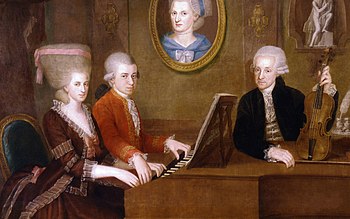 |
| Family portrait: Maria Anna ("Nannerl") Mozart, her brother Wolfgang, their mother Anna Maria (medallion) and father, Leopold Mozart (Photo credit: Wikipedia) |
Leopold, Mozart's father, was a fine musician and had a wide reputation as a wonderful violin teacher. It is he who was Mozart's first music instructor and who introduced Mozart to the public. At the age of five, with his father's guidance, Mozart began to give performances.
Mozart was a prolific composer of opera, keyboard works, vocal pieces, symphonies and chamber music. He was a gifted pianist, violinist, and conductor. Nearly all of his compositions were commissioned works, no commission being too small or too large. Mozart's music is a depiction of the man himself, ranging in moods of comical, noble tragedy, simplistic elegance, courtly majesty and heroic works full of the spirit of freedom.
In December of 1774, Mozart traveled to Munich where he composed a set of six sonatas, K. 282 in E-flat Major included. These six sonatas represent Mozart's earliest surviving works in this genre. Mozart's early works are a light, cheerful style associated with the Galant movement in Italy. The Galant movement was an emphasis on classical simplicity (such as less ornamentation, an increase in the importance of the melody, musical phrases of a regular length and so forth), as compared to the complexity and ornate nature of the Baroque era.
Mozart also modeled his compositional style after many of his contemporaries, including Carl Phillip Emanuel Bach, Johann Christian Bach, and Franz Joseph Haydn. It is Haydn's influence that is particularly noted in K. 280, 281, and 282.
Mozart's keyboard sonatas were not originally intended for the concert platform, but instead for a more private context. They were valuable tools for teaching and they also provided repertoire material for Mozart's performances in the homes of patrons.
The Sonata in E-flat Major, K. 282, begins atypically with an Adagio movement. The movement is in a two-part form or binary form. This first movement, in the key of B-flat Major, is very expressive melodically and demonstrates a strong interplay between forte and piano.
The second movement consists of two minuetts, in the keys of B-flat and E-flat Major. The first of the two minuetts is simple, yet energetic, and reminiscent of Haydn's style. The second of the minuetts has a livelier left-hand accompaniment and "snap-rhythms." This second movement also exhibits the same striking contrasts between forte and piano.
The third movement, in the key of E-flat Major, is in miniature sonata allegro form with a very short development and a full recapitulation. The upbeat motive recurs in a variety of forms, giving an impression of compact unity to the whole movement. This motive also serves as the thematic basis for the development section. The recapitulation begins exactly as the exposition. The coda, tail/ending extends the opportunity to show off the pianist's technical ability and ends almost as an afterthought. It is as though the pianist has stopped, but the music continues on.
Find quality resources for piano teachers, students, and parents at Piano Discoveries. http://www.pianodiscoveries.com Article Source: EzineArticles |

No comments:
Post a Comment